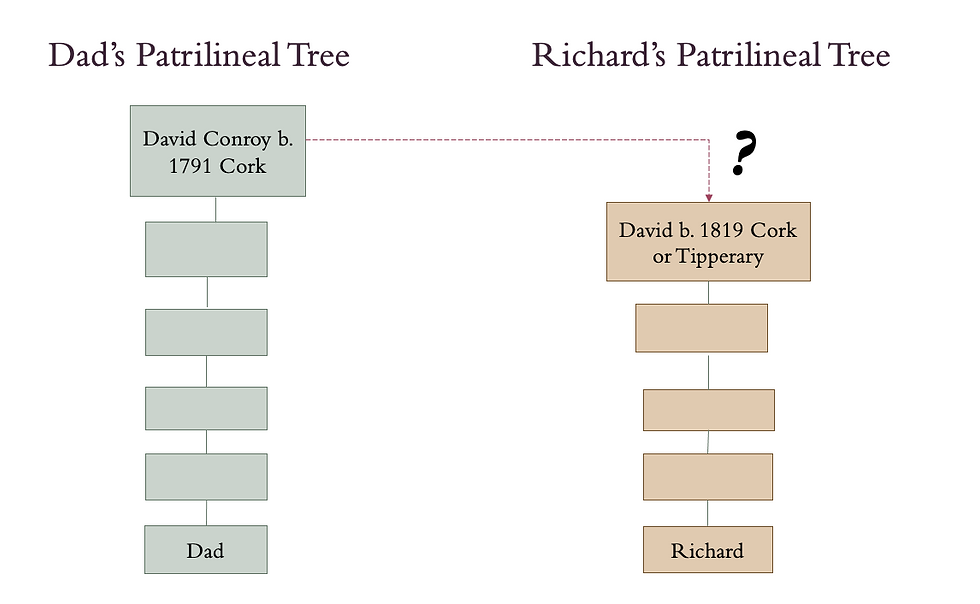Peter Robinson Settlement celebrations & DNA Project
- Colleen Murray

- Sep 15
- 4 min read
This summer I had the pleasure of attending the celebrations in Douro, Peterborough, Ontario for the Peter Robinson Settlement’s 200th anniversary. The Peter Robinson Settlers were poor Irish who were assisted to emigrate to Peterborough in 1823, with a much larger group arriving in 1825. David Conroy & Catherine Sullivan, and Edmond Allen & Bridget Fleming are my Peter Robinson ancestors. I have blogged about my research on the Conroy family a few times before.
While I briefly visited Peterborough about 15 years ago, this was my first visit to Douro, the specific township where my ancestors settled. Douro was lovely, and I thoroughly enjoyed the program the volunteers of the celebration set up. I also had the chance to see the original farm sites and meet cousins who still lived in the area!

Some Peter Robinson Settler descendants have kept the celebration going, by adding a trip to Ireland this month, where more commemorations are taking place. Unfortunately, I’m not there to join in on the fun.
Instead, back at home on my computer, checking my FamilyTreeDNA (FTDNA) results, I stumbled upon a Group Project for Peter Robinson’s Settlers descendants. Although the project has been in existence for a few years, this was the first time I’d seen it, so I quickly joined. Group Projects at FTDNA are a great way to explore surnames, locations, and, in this case, settler groups. Group Projects are run by volunteers who share of their time and DNA knowledge to help us explore these topics.
The Peter Robinson’s Settlers Group Project is for anyone who has a DNA test of any kind at FTDNA, whether their ancestor was part of the 1823 or the 1825 emigration. The project’s goal is to “verify genetically one or more generations of Peter Robinson’s settler descendants with at least one generation of their ancestors in Ireland”.

One of the great things about a group like this is it provides a place to find cousins who may have inherited DNA you didn’t get. For example, my Dad inherited his emigrant ancestor David Conroy’s Y-DNA. David had many descendants, but few were on the right inheritance path (the patrilineal line, connecting father to son in an unbroken male chain) to inherit his Y-DNA. By joining this Group Project, others who don’t carry David’s Y-DNA can still connect with those who do, and they can learn about the haplogroup assigned to these descendants.
I was hoping to find a Y-DNA tester who descends from Edmond Allen in the Group Project. Dad and I have some Allen autosomal DNA, but Dad doesn’t carry the Allen Y-DNA. While there are other Edmond Allen descendants in the project already, either none has taken a Y-DNA test, or none descends from Edmond on their patrilineal line. Edmond had a lot of descendants, so I’m sure there is a Y-tester out there somewhere, we just need to get them to join the Group Project to represent Edmond.
My Dad has also taken a Mitochondrial DNA test (mtDNA), which traces his matrilineal ancestry. (Dad’s mother’s mother’s mother’s line etc.) But for Dad, his matrilineal ancestor was not a Peter Robinson settler. Unfortunately, neither of Dad’s female Peter Robinson settler ancestors (Bridget Fleming and Catherine Sullivan) have testers representing their mtDNA in the project so far. But I will keep checking back!
Wouldn’t it be great if we could identify many of the Y-DNA haplogroups for the Peter Robinson men and the mtDNA haplogroups for the Peter Robinson women? By joining the project, you can see if other cousins have already tested these lines, and if they haven’t, maybe you’d consider testing yourself, if you descend in the correct way.
Other than learning our ancestors’ haplogroups, joining a Group Project can help us work on our shared genealogy. Peter Robinson Settlers intermarried in Canada, and since they were recruited from a relatively small area in Ireland, some of the families may have also intermarried prior to emigration. So researching our genealogy really is a shared process, and when we work with autosomal DNA results, we need to keep in mind this shared kindship that can impact the analysis of our results.
Ways to join the project:
Take a DNA test from FamilyTreeDNA and then request to join the group project. You’ll need to explain which Peter Robinson’s Settler you descend from.
OR You can transfer a copy of an autosomal DNA test that you took elsewhere (Ancestry, MyHeritage, 23andme etc.) to FamilyTreeDNA for free. *There is an optional one-time fee of $19 US to unlock all of their DNA tools.
Consider taking a Y-DNA test or mtDNA test, especially if your Peter Robinson ancestor is on your patrilineal or matrilineal line.
*Read the terms of service & privacy policy before transferring your DNA anywhere.
**I am not associated with FTDNA, or with this group project, other than being a customer and project member!


Comments